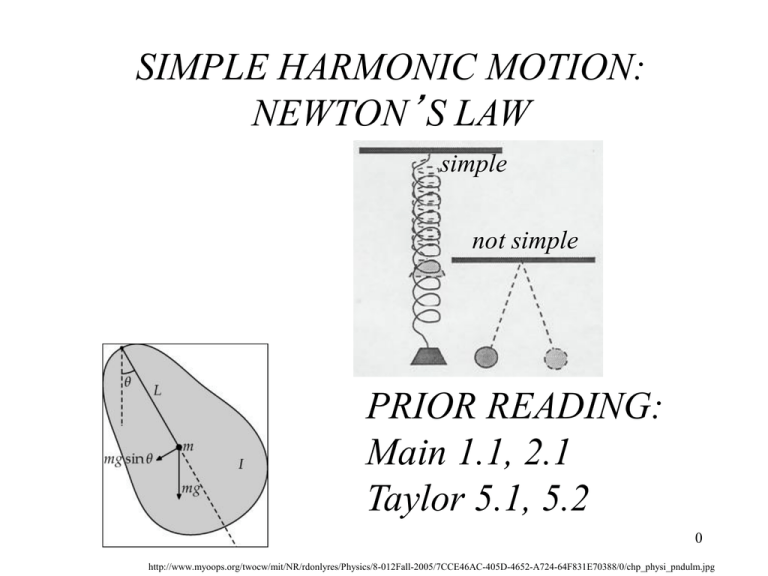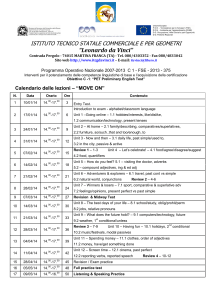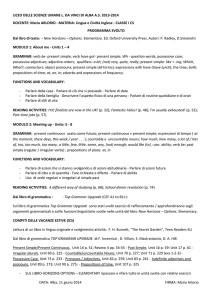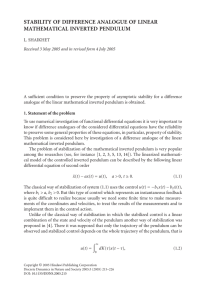L4 - Physics at Oregon State University
advertisement

SIMPLE HARMONIC MOTION: NEWTON’S LAW simple not simple PRIOR READING: Main 1.1, 2.1 Taylor 5.1, 5.2 0 http://www.myoops.org/twocw/mit/NR/rdonlyres/Physics/8-012Fall-2005/7CCE46AC-405D-4652-A724-64F831E70388/0/chp_physi_pndulm.jpg The simple pendulum r; r = L q T Energy approach q 0 0 dq ' ò t ' = qò m mg t t= 2 E - mgLcm (1- cosq ')) ( I q òq 0 dq ' 2mgLcm 1- cosq max - (1- cosq ')) ( 2 mLcm t= q òq 0 dq ' 2g cosq '- cosq max ) ( Lcm 1 Lcm = L q T The simple pendulum Energy approach t= m q dq ' òq 2g cosq '- cosq max ) ( Lcm 0 mg g w0 º L angular frequency w t = arcsin q q max t= q òq 0 q0 - arcsin q max f dq ' g 2 q max- q '2 L ( q q' = arcsin w0 q max q 1 ) 0 Þ q ( t ) = q max sin (w t + f ) 2 r; r = L q T The simple pendulum m t = Iq t = r ´ åF = ? mg Newton Known torque ˆ t = Lmgsinq Ä Iq = mL2q ·ˆ g q = - sin q L This is NOT a restoring force proportional to displacement (Hooke’s law motion) in general, but IF we consider small motion, IT IS! Expand the sin series … sin q = q - q3 3! + q5 5! + ... 3 q L T m mg The simple pendulum in the limit of small angular displacements g q = - sin q ® L g g q = - q or q + q = 0 L L k Compare with x + x = 0 m What is q(t) such that the above equation is obeyed? q is a variable that describes position t is a parameter that describes time "dot" and "double dot" mean differentiate w.r.t. time g, L are known constants, determined by the system. 4 REVIEW PENDULUM q g q+ q=0 L L T q (t) = Ce m mg pt C, p are unknown (for now) constants, possibly complex q (t) = p 2Ce pt = p 2q (t) Substitute: g pq+ q=0 L 2 g p = ±i = ±iw 0 L p is now known (but C is not!). Note that w0 is NOT a new quantity! It is just a rewriting of old ones - partly 5 shorthand, but also "w" means "frequency" to physicists! REVIEW PENDULUM q L TWO possibilities …. general solution is the sum of the two and it must be real (all angles are real). T m iw 0t q (t) = Ce + C 'e -iw 0t mg If we force C' = C* (complex conjugate of C), then x(t) is real, and there are only 2 constants, Re[C], and Im[C]. A second order DEQ can determine only 2 arbitrary constants. q (t) = Ceiw t + C *e-iw t 0 0 Simple harmonic motion 6 REVIEW PENDULUM q L T m q (t) = Ceiw t + C *e-iw t 0 Re[C], Im[C] chosen to fit initial conditions. Example: q(0) = 0 rad and dqdt(0) = 0.2 rad/sec mg q (0) = C e iw 0 0 0 +C*e -iw 0 0 1 q (0) iw0C eiw 0 iw0C * e iw 0 0 1 1 0 1 0 = C + C* = 2 Re[C] 0.2rad / s iw0 C C * iw0 2i Im[C ] Þ Re[C] = 0 0.2 0.1 Im[C ] 2w0 w0 C 0i 0.1 w0 cartesian 0.1 w0 i e 2 ; C* ? polar 7 REVIEW PENDULUM q L T m mg q (t ) Ceiw t C *eiw t ; C 0 q (t) = q (t) = q (t) = 0.1 w0 0.1 w0 0.1 w0 0 i p e e 2 (e iw 0 t + i(w 0 t+p /2 ) 0.1 w0 +e e -i 0.1 w0 p 2 e i e2 -iw 0 t -i(w 0t+p /2) ) ( 2 cos (w t + p / 2)) 0 æ ö q (t) = cos çw 0 t + p / 2 ÷ w0 è f ø 0.2 A 8 Remember, all these are equivalent forms. All of them have a known w0=(g/L)1/2, and all have 2 more undetermined constants that we find … how? q (t) = A cos (w 0t + f ) q (t) = Bp cos w 0t + Bq sin w 0t q (t) = C exp ( iw 0t ) + C * exp ( -iw 0 t ) q (t) = Re éë D exp ( iw 0t ) ùû Do you remember how the A, B, C, D constants are related? If not, go back and review until it becomes second nature! 9 q L T m mg g w0 = L L T = 2p g The simple pendulum ("simple" here means a point mass; your lab deals with a plane pendulum) g q=- q L q(t) = qmax cos(w 0t + f ) simple harmonic motion ( potential confusion!! A “simple” pendulum does not always execute “simple harmonic motion”; it does so only in the limit of small amplitude.) Period does not depend on qmax, f 10 Free, undamped oscillators – other examples k m L No friction k m x I C q 1 q=q LC mx = -kx r; r = L q Common notation for all T m mg g q»- q L y +w y = 0 2 0 • The following slides simply repeat the previous discussion, but now for a mass on a spring, and for a series LC circuit 12 REVIEW MASS ON IDEAL SPRING F(x) = mx k k m F(x) = -kx m -kx = mx x k x+ x=0 m Newton Particular type of force. m, k known Linear, 2nd order differential equation What is x(t) such that the above equation is obeyed? x is a variable that describes position t is a parameter that describes time "dot" and "double dot" mean differentiate w.r.t. time m, k are known constants 13 REVIEW MASS ON IDEAL SPRING k k k x+ x=0 m m x(t) = Ce m x pt C, p are unknown (for now) constants, possibly complex x(t) = p 2Ce pt = p 2 x(t) Substitute: k p x+ x=0 m 2 k p = ±i = ±iw 0 m p is now known. Note that w0 is NOT a new quantity! It is just a rewriting of old ones - partly shorthand, but also “w” 14 means “frequency” to physicists! x(t) = A cos (w 0t + f ) k k m A, f chosen to fit initial conditions: x(0) = x0 and v(0) = v0 x0 = A cos f v0 = -w 0 Asin f m x Square and add: Divide: x02 + v02 w 2 0 ( ) = A 2 cos 2 f + sin 2 f = A 2 -v0 = tan f w 0 x0 15 x(t) = A cos (w 0t + f ) æ k æ -v0 ö ö x(t) = x + 2 cos ç t + arctan ç ÷ø ÷ w0 m w x è è 0 0 ø 2 0 v02 x(t) = Acos f cos w 0t - Asin f sin w 0t Aeif iw 0t Ae-if -iw 0t x(t) = e + e 2 2 x(t) = Re éë Aeif eiw 0t ùû 2 arbitrary constants (A, f because 2nd order linear differential equation 16 x(t) = A cos (w 0t + f ) Position: • A, f are unknown constants - must be determined from initial conditions • w0, in principle, is known and is a characteristic of the physical system Velocity: dx º x(t) = -w 0 Asin (w 0 t + f ) dt d x 2 º x(t) = w 0 A cos (w 0 t + f ) 2 dt = -w 02 x(t) 2 Acceleration: This type of pure sinusoidal motion with a single frequency is called SIMPLE HARMONIC MOTION 17 THE LC CIRCUIT DIFFERENTIAL EQUATION q VC = C 2 dI d q VL = L = L 2 = Lq dt dt L I C q VL + VC = 0 Kirchoff’s law (not Newton this time) q L q 0 C 1 q=q LC k x x m Same differential equation as the SHO spring! What is inductance?? d L dI It is how much magnetic flux is created in the inductor coil by a given current I, in a wire. What is the voltage change across an inductor? A voltage change occurs WHEN there is change in magnetic flux (i.e. some of the energy is ‘converted’ to a magnetic field) d d dI dI VL L dt dI dt dt 19 THE LC CIRCUIT VL + VC = 0 L I C q Kirchoff’s law (not Newton this time) dI d 2q VL = L = L 2 = Lq dt dt q VC = C 1 q=q LC


